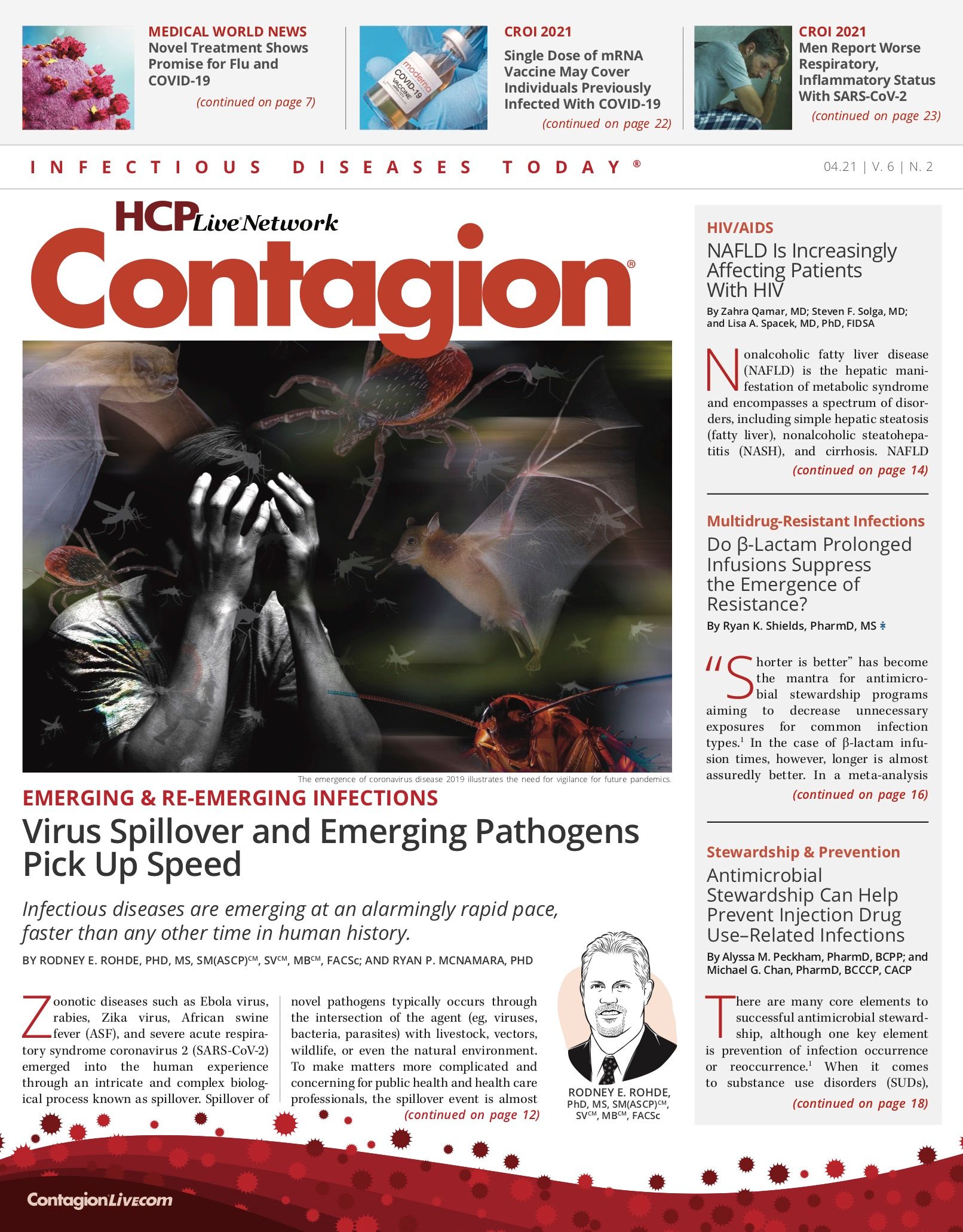Do β-Lactam Prolonged Infusions Suppress the Emergence of Resistance?
This approach can help with clinical outcomes and mortality, but resistance is not as well defined.

“Shorter is better” has become the mantra for antimicrobial stewardship programs aiming to decrease unnecessary exposures for common infection types.1 In the case of β-lactam infusion times, however, longer is almost assuredly better. In a meta-analysis of 1876 patients, prolonged infusions (≥3 hour infusion time) of antipseudomonal β-lactams were associated with lower all-cause mortality among patients with sepsis compared with shorter bolus infusions (≤1 hour infusion time; risk ratio=0.70; 95% CI 0.56-0.87).2 Indeed, prolonged or continuous β-lactam infusions achieve higher rates of pharmacokinetic-pharmacodynamic (PK-PD) target attainment, which results in a greater probability of clinical cure from severe infection.3 The contemporary PK-PD target for β-lactams to optimize efficacy is to maintain free (unbound) plasma drug concentrations above the minimum inhibitory concentration (MIC) against the causative pathogen for 100% of the dosing interval (fT>MIC).3-5 Recent observational studies have further corroborated the importance of prolonged infusions for ceftolozane-tazobactam and ceftazidime-avibactam to improve clinical outcomes among patients infected with carbapenem-resistant Pseudomonas aeruginosa and Enterobacterales (CRE), respectively.6,7 Taken together, prolonged infusion β-lactam therapy improves clinical outcomes and lowers mortality. Whether this approach will curb the risk for the emergence of resistance is less well-defined. It is an active research priority in studies assessing the clinical impact of β-lactam therapeutic drug monitoring (TDM).
β-lactam resistance against P aeruginosa is a focal point of hospital antibiograms due to the direct association with high rates of treatment failure, recurrent infections, and empiric treatment selection. Each day of antipseudomonal β-lactam therapy carries a 4% increased risk for subsequent resistance.8 In clinical trials of hospital- and ventilator-associated pneumonia (VAP) due to P aeruginosa, 10% to 50% of patients treated with β-lactams developed resistance.9,10 Hopes for improved durability of newer agents such as ceftolozane-tazobactam have been dashed by recent reports documenting treatment-emergent resistance within the same range.6,11 Thus, a more aggressive β-lactam PK-PD target of 100% fT>4x MIC has been proposed by consensus guidelines to both optimize efficacy and suppress the emergence of resistance.12 The recommendation accounts for several factors, including variability in MIC determination, inaccuracies of β-lactam plasma concentration measurements, exposures at the site of infection, and the relative safety of β-lactams. At the same time, it is important to highlight that clinical data linking prolonged infusions to suppression of resistance are lacking and preclinical experimental models offer mixed results.
Felton et al compared the effectiveness of bolus versus prolonged infusions of piperacillin-tazobactam to suppress resistance against P aeruginosa PAO1 in a hollow-fiber infection model (HFIM).13 At low inocula (104 cfu/mL), trough piperacillin/MIC ratios of 3.4 for bolus infusions and 10.4 for prolonged infusions were required to suppress resistance; expansion of resistant subpopulations, however, occurred at similar rate with either infusion strategy. At higher inocula (107 cfu/mL), amplification of resistant subpopulations occurred with all doses (up to 17g/day piperacillin) administered as either a bolus or prolonged infusion. Extending these studies, Tam et al used classification and regression tree analysis to determine that a ceftazidime, cefepime, or meropenem trough/MIC ratio of 3.8 was required to suppress resistance against a baseline inocula of 108 cfu/mL P aeruginosa in an HFIM.14 The in vitrodata demonstrate that β-lactam trough concentrations of at least 3x MIC are required to suppress resistance, but resistance may not be reliably suppressed at higher bacterial inocula. These data most directly apply to patients with VAP or other high-inocula infection types where bacterial densities often exceed the natural inverse of the β-lactam mutational frequency, suggesting that resistant subpopulations are present at baseline and selected for over time.15 Accordingly, suppression of β-lactam resistance during or following treatment with prolonged infusions should be viewed through the lens of the initial bacterial burden, infecting pathogen, patient characteristics, duration of treatment, and antibiotic exposures at the site of infection.
To illustrate the importance of these factors on suppression of resistance, Yusuf et al showed that receiving meropenem for greater than 8 days was independently associated with the emergence of meropenem-resistant P aeruginosa infections after adjustment for age, gender, severity of illness, and length of stay.16 Interestingly, rates of resistance were nearly identical for patients receiving prolonged (45.5%, n=46) or bolus (43.5%, n=11) meropenem infusions. Similarly, Dhaese et al found no difference in the risk for resistance among patients receiving continuous versus bolus infusions of piperacillin-tazobactam or meropenem after multivariate adjustment.17 Although only 11.7% (24/205) of patients developed resistance in this retrospective cohort study, 34% (14/41) of patients infected with P aeruginosa developed resistance, which was the only factor independently predictive of emergent resistance. TDM and molecular analysis of resistant isolates were not performed in either study. In contrast, real-time TDM was performed in a recent study by Cojutti et al. They used continuous infusions of meropenem to target a meropenem/MIC ratio of 4:8 among patients with febrile neutropenia.18 Twenty percent of patients in this study had documented gram-negative infections (n=15; 4 with P aeruginosa), and no patients developed CRE colonization within 3 months of treatment. TDM-guided β-lactam therapy provides important supportive data to institute prolonged infusions and optimize exposures necessary to suppress resistance that has been shown to vary across patient populations. In a prospective, observational study of critically ill patients in the Netherlands, only 37% achieved a PK-PD target of 100% fT>4x MIC.19 Factors associated with lower rates of target attainment included an eGFR of 90 mL/min/1.73m2 or greater and higher BMI. To demonstrate the utility of TDM-guided therapy, Al-Shaer et al reported outcomes of 206 patients who had β-lactam levels measured as standard of care.20 Overall, 8% (17/206) of patients developed resistance, but more importantly, attainment of β-lactam exposures 100% fT>4x MIC was independently associated with suppression of new resistance (P=0.0043).
Identifying and characterizing the emergence of β-lactam resistance in clinical trials is a major challenge due to short observation periods, sparse microbiologic sampling, and a reliance upon categorical MIC interpretations. In randomized and observational studies assessing the impact of β-lactam prolonged infusion,5,20 microbiologic eradication is often assumed and not measured. Confounding interpretation of these data, resistance is typically defined by a single representative isolate that may not be related to the isolate identified at baseline. Population estimates derived from clinical breakpoints also have been used.19 Neither approach, however, interrogates the within patient evolution of resistant or heteroresistant bacterial populations that are common for P aeruginosa and other multidrug-resistant gram-negative pathogens. On the whole, the impact of β-lactam prolonged infusion on suppression of resistance has not been appropriately delineated, and mixed clinical results are not surprising. Moving forward, additional real-world data are needed to inform β-lactam dosing strategies within well-defined patient populations and specific infection types. Current studies can be advanced by capturing outcomes over time that include both clinical efficacy and microbiologic end points derived from studying bacterial populations rather than single isolates or clones. Until such time, prolonged infusions of β-lactams undeniably improve patient outcomes and should be implemented whenever possible. The full benefits of this approach, however, are still to be determined.
Ryan K. Shields, PharmD, MS, associate director, Antibiotic Management Program, Division of Infectious Diseases at the University of Pittsburgh in Pennsylvania. Shields also is content editor for the Multidrug-Resistant Infections section of Contagion.®
References
1. Spellberg B, Rice LB. Duration of Antibiotic Therapy: Shorter Is Better. Ann Intern Med 2019;171:210-1.
2. Vardakas KZ, Voulgaris GL, Maliaros A, Samonis G, Falagas ME. Prolonged versus short-term intravenous infusion of antipseudomonal beta-lactams for patients with sepsis: a systematic review and meta-analysis of randomised trials. The Lancet Infectious Diseases 2018;18:108-20. 3. Abdul-Aziz MH, Sulaiman H, Mat-Nor MB, et al. Beta-Lactam Infusion in Severe Sepsis (BLISS): a prospective, two-centre, open-labelled randomised controlled trial of continuous versus intermittent beta-lactam infusion in critically ill patients with severe sepsis. Intensive Care Med 2016;42:1535-45.
4. Abdul-Aziz MH, Alffenaar JC, Bassetti M, et al. Antimicrobial therapeutic drug monitoring in critically ill adult patients: a Position Paper. Intensive Care Med 2020.
5. Roberts JA, Paul SK, Akova M, et al. DALI: defining antibiotic levels in intensive care unit patients: are current beta-lactam antibiotic doses sufficient for critically ill patients? Clinical infectious Diseases : an official publication of the Infectious Diseases Society of America 2014;58:1072-83.
6. Tamma PD, Beisken S, Bergman Y, et al. Modifiable Risk Factors for the Emergence of Ceftolozane-Tazobactam Resistance. Clinical Infectious Diseases : an official publication of the Infectious Diseases Society of America 2020.
7. Tumbarello M, Raffaelli F, Giannella M, et al. Ceftazidime-avibactam use for KPC-Kp infections: a retrospective observational multicenter study. Clinical Infectious Diseases : an official publication of the Infectious Diseases Society of America 2021.
8. Teshome BF, Vouri SM, Hampton N, Kollef MH, Micek ST. Duration of Exposure to Antipseudomonal beta-Lactam Antibiotics in the Critically Ill and Development of New Resistance. Pharmacotherapy 2019;39:261-70.
9. Fink MP, Snydman DR, Niederman MS, et al. Treatment of severe pneumonia in hospitalized patients: results of a multicenter, randomized, double-blind trial comparing intravenous ciprofloxacin with imipenem-cilastatin. The Severe Pneumonia Study Group. Antimicrobial Agents and Chemotherapy 1994;38:547-57.
10. Rea-Neto A, Niederman M, Lobo SM, et al. Efficacy and safety of doripenem versus piperacillin/tazobactam in nosocomial pneumonia: a randomized, open-label, multicenter study. Curr Med Res Opin 2008;24:2113-26.
11. Haidar G, Philips NJ, Shields RK, et al. Ceftolozane-Tazobactam for the Treatment of Multidrug-Resistant Pseudomonas aeruginosa Infections: Clinical Effectiveness and Evolution of Resistance. Clinical Infectious Diseases : an official publication of the Infectious Diseases Society of America 2017;65:110-20.
12. Guilhaumou R, Benaboud S, Bennis Y, et al. Optimization of the treatment with beta-lactam antibiotics in critically ill patients-guidelines from the French Society of Pharmacology and Therapeutics (Societe Francaise de Pharmacologie et Therapeutique-SFPT) and the French Society of Anaesthesia and Intensive Care Medicine (Societe Francaise d'Anesthesie et Reanimation-SFAR). Critical care 2019;23:104.
13. Felton TW, Goodwin J, O'Connor L, et al. Impact of Bolus Dosing versus Continuous Infusion of Piperacillin and Tazobactam on the Development of Antimicrobial Resistance in Pseudomonas aeruginosa. Antimicrobial Agents and Chemotherapy 2013;57:5811-9.
14. Tam VH, Chang KT, Zhou J, et al. Determining beta-lactam exposure threshold to suppress resistance development in Gram-negative bacteria. The Journal of Antimicrobial Chemotherapy 2017;72:1421-8.
15. Zedtwitz-Liebenstein K, Schenk P, Apfalter P, et al. Ventilator-associated pneumonia: Increased bacterial counts in bronchoalveolar lavage by using urea as an endogenous marker of dilution. Critical Care Medicine 2005;33:756-9.
16. Yusuf E, Van Herendael B, Verbrugghe W, et al. Emergence of antimicrobial resistance to Pseudomonas aeruginosa in the intensive care unit: association with the duration of antibiotic exposure and mode of administration. Ann Intensive Care 2017;7:72.
17. Dhaese SAM, De Kezel M, Callant M, et al. Emergence of antimicrobial resistance to piperacillin/tazobactam or meropenem in the ICU: Intermittent versus continuous infusion. A retrospective cohort study. J Crit Care 2018;47:164-8.
18. Cojutti PG, Lazzarotto D, Candoni A, et al. Real-time TDM-based optimization of continuous-infusion meropenem for improving treatment outcome of febrile neutropenia in oncohaematological patients: results from a prospective, monocentric, interventional study. The Journal of Antimicrobial Chemotherapy 2020;75:3029-37.
19. Abdulla A, Dijkstra A, Hunfeld NGM, et al. Failure of target attainment of beta-lactam antibiotics in critically ill patients and associated risk factors: a two-center prospective study (EXPAT). Critical Care 2020;24:558.
20. Al-Shaer MH, Rubido E, Cherabuddi K, Venugopalan V, Klinker K, Peloquin C. Early therapeutic monitoring of beta-lactams and associated therapy outcomes in critically ill patients. J Antimicrob Chemother 2020;75:3644-51.

